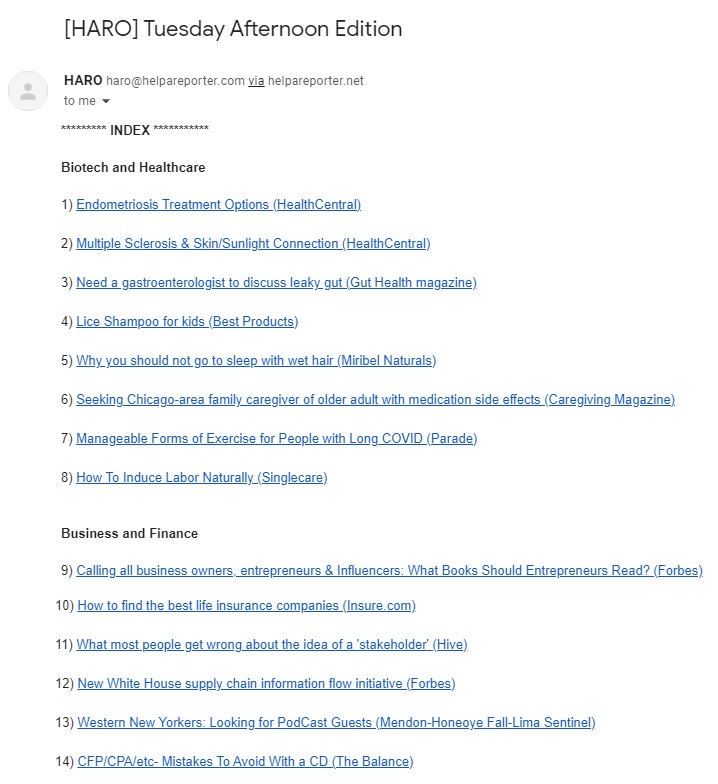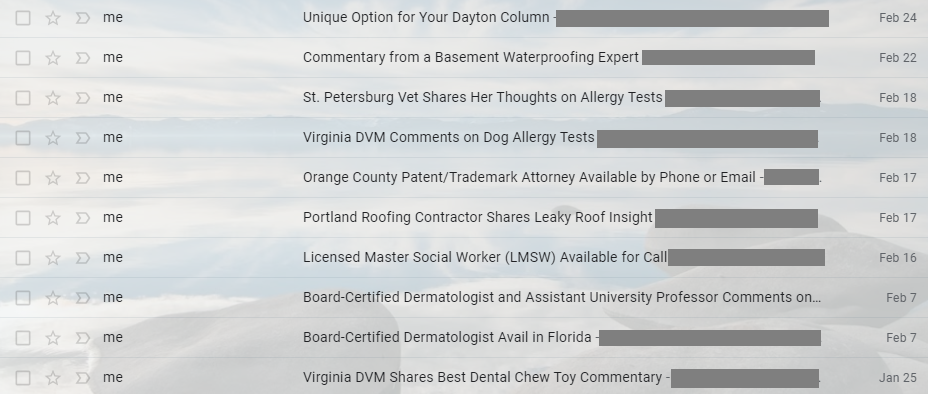🔥 Whitespark's Local Ranking Grids are coming soon! Get notified when we launch
🔥 Whitespark's Local Ranking Grids are coming soon! Get notified when we launch

Post Originally Published – Mar 16, 2016
Link building is often one of the most challenging areas for local businesses when it comes to their local SEO strategy. Help A Reporter Out is one strategy that can help business owners grow their prominence and publicity. Wes is sharing 10 of his HARO outreach strategies that are still going strong six years later.
You’re a local business looking for publicity and for links, and reporters are looking for authorities to quote. Help a Reporter Out – also known as HARO – connects reporters and sources (like you) in a daily email. (More details here, if you’d like to learn how it works.)
(More details here, if you’d like to learn how it works.)
HARO’s an excellent way for local businesses to secure valuable links from desirable publications. This alone is enough reason to try it, as these links help boost your organic rankings while providing a shareable asset for branding.
However, another benefit that’s equally rewarding is how these links create an expanding divide between you and your competitors who are not engaging with HARO. Like good SEO, earned-media link building takes time and it’s not a sprint. Competitors who don’t want to put in consistent work will often send in pitches that reporters aren’t interested in. They’ll conclude HARO doesn’t work for them, and never bother with it again.
Meanwhile, someone like you is strengthening their online presence and visibility for long-term success while chipping away at HARO by getting links one by one.
HARO should not be your only tool for outreach or SEO, but becoming comfortable with it is a valuable skill to learn. I’ve used HARO since 2011, but only began extensively tracking every pitch I made (plus rejections!) since 2019. That tracking made something apparent – I’ve had great success securing quality media links for clients through HARO. For those who like numbers, here are mine:
I should clarify that when I began using HARO in 2011 I was not as efficient or effective, as I was still learning the tactic and toying with different approaches. Through trial and error, I believe I found my groove about 6-8 months in. I’d say the hardest part when starting out is how writers will regularly not reply to you whether they liked your submission or not. That’s discouraging after spending nearly an hour of our time (and the client’s budget) for a big ol’ bag of nothing.
HARO is only one tactic I do for clients, so it does not have to be a full-time commitment. While I can’t share all of my secrets (a guy’s gotta remain somewhat desirable for consulting contracts) here are some of my favorite tips…
1.Scan the HARO emails within the first 10 minutes of getting the alert. If you’re working on behalf of the expert, this will provide you with as much time as possible to get their reply so you can produce an early delivery (hopefully, one of the first “good ones”). If you are the expert, my lord, you can just start hammering out your pitches nearly instantaneously, which is so lucrative. Get some! 2. Submit the pitch to the writer’s HARO email – not their work or personal emails: For the unfamiliar, HARO operates similarly to CraigsList, where the correspondence begins semi-anonymously. The writer shares their Name, Media Outlet, Query, Deadline, and Requirements with the option for you to share your pitch with them via a HARO-generated email address. This is primarily for their privacy. Then the writer gets an alert to log-in to their account’s dashboard and review your submission, along with others. From there, the writer can then deny your pitch, accept it as-is, or choose to reply to you directly for any number of reasons. It is at this time your new contact elicits direct contact from you.
2. Submit the pitch to the writer’s HARO email – not their work or personal emails: For the unfamiliar, HARO operates similarly to CraigsList, where the correspondence begins semi-anonymously. The writer shares their Name, Media Outlet, Query, Deadline, and Requirements with the option for you to share your pitch with them via a HARO-generated email address. This is primarily for their privacy. Then the writer gets an alert to log-in to their account’s dashboard and review your submission, along with others. From there, the writer can then deny your pitch, accept it as-is, or choose to reply to you directly for any number of reasons. It is at this time your new contact elicits direct contact from you.
Why the laborious lesson on HARO?
In the original 2016-version of this article, I actually recommended emailing writers at their direct addresses to stand out from the cattle-call that is HARO. However, I have since spoken with more writers and their input is that they prefer having replies in HARO’s dashboard vs getting pinged by randos like they’re at an Applebee’s happy hour!
When HARO was less popular, I found that standing out by emailing them directly was clever and often led to fun engagements with the writers. Fast forward 6 years and HARO is now more popular, with writers getting ridiculous volumes of submissions (at times 125+/request). The writers of today need to contain everything within the HARO ecosystem for their own time-management and sanity. This is why writers now find my previous approach somewhat intrusive, so I’ve quit doing that. There are some occasions where I’ll revert to my old ways, like trying my hand at nepotism with a writer I’ve successfully worked with in the past, but my rule of thumb is to avoid it.
3. Read, re-read, and follow the reporter’s instructions. Not following the reporter’s instructions is a common mistake, but an easily avoidable one. If the writer is asking for something specific, there’s a reason. Strive to provide them with a completed honey-do list in your initial outreach. If they say, “provide five (5) examples of XYZ”, provide them with five and not three. If they say, “must be a board-certified dermatologist” don’t reply if you’re an esthetician. The writer probably has early approval for a story or the framework of the article already in mind, so that’s why they asked for specifics. When in doubt, just remember this scene in The Break-Up and get the writers their 12 lemons.4. Pitch as early in the submission window as possible. Unlike journalism of decades past, very few modern writers have the luxury of sinking a week+ nurturing a single story. Nowadays, these digital authors are required to knock out articles daily and in high volume. This change of industry created a lot of urgency that trickles down to HARO. You’ll commonly see requests that are due in 5 to 24 hours, so it can create some whiplash!
I have no way to verify this, but it’s my belief that most writers will take a good submission from a qualified source earlier than a better submission from an equally credentialed expert near the end of the submission window. Speed is the game and good-enough can win. When I started connecting with writers and journalists earlier in their submission cycle, my success rate improved significantly.
5. Subscribe to too many categories rather than to too few. It’s easier to skim and delete an email than not to see it at all. If you’re a physician you might think you need to only subscribe to “Medical Health,” but you’re only going to get hyper-direct inquiries with that approach. What about “Entrepreneurship,” “Human Resources,” “Local Regions,” and “Technology”? You’re not just some “expert”; you’re also a business owner. (image credit – Andrew Malone)
(image credit – Andrew Malone)
6. Always mention a sequence of details in the Subject line for your ease of tracking. If you’re in an agency-role and pitching for your roster of clients, this is a lifesaver. If you look at your Sent folder you’ll simply see a bunch of anonymous HARO emails, but which was for Client A and which was for Client B? I always recommend mentioning the expert’s location, credentials, and that their commentary is included within the subject line.
An example would be “Edmonton SaaS Founder Comments on XYZ” if I were pitching Darren Shaw to an outlet. This allows me to scan my outbound pitches without having to click each email to investigate.
Additionally, it quickly provides the writer with the Who, Where, and Why of The 5 Ws for quick validation. 7. Reiterate the query in the introduction of the pitch. On the heels of the Subject line tip, I always recommend mentioning the following in your initial pitch: the writer’s name, their query summary, and the outlet. It would look like this as an example:
7. Reiterate the query in the introduction of the pitch. On the heels of the Subject line tip, I always recommend mentioning the following in your initial pitch: the writer’s name, their query summary, and the outlet. It would look like this as an example:
“Hi WRITER,
My name is Wes and I’m writing in response to your HARO request for OUTLET NAME where you’ll be discussing TOPIC. I was able to connect with CLIENT who is a CREDENTIALS in LOCATION. They share their insight on TOPIC below for your review and consideration.”
Trust me, this will help you immensely if you want to check in on a past pitch. I can rarely remember passing details but I can remember hot-ticket outlets I pitched or the topic. Keep in mind that many writers will not notify you in any capacity on your pitch, so don’t assume they’ll tell you it’s been used and published. I share this because the technique above allows you to do your own searching by Author Name + Outlet + Topic.
8. Keep it snappy. If you’re representing clients, this one is for you, as many writers already view PR pros as a sort of roadblock that prevents them from getting direct access to the expert.
In the past, I didn’t respect the number of pitches HARO reporters received. This led to me sending super-glossy and detailed emails introducing myself, the client, and their expertise. I thought this would get me more takers. It did not. Writers care about the insight and don’t have the luxury to read superfluous backstories and pleasantries from a potentially one-off engagement. One day I pretended I was Tom Cruise in Risky Business and said to myself, “Oh, what the fu…dge” and just started rattling off short and simple intros. That worked better.
9. Know that nice people finish first. Think about how you engage with people in every part of your life. Do you smile, ask questions, and thank your server at dinner? If so, did you have a more pleasant experience due to the care you put into it? Do you think the server gave potentially better service because you cared and made their table experience personal? If so, what stops you from doing that in all areas of your life? I try to give the same attention and care to a reporter I have never met and might not hear back from as I would to anyone. Sincerity goes a long way.
10. AVOID promotion and focus on education. This one is important and I can’t stress it enough to new clients. Oftentimes, they’ll want to incorporate their business name, business offerings, or more self-promotional elements into their commentary. Don’t do that…even a lil bit. Technically, you’re not the star here, as the writer is the maestro, and this isn’t marketing copywriting but traditional Q&A interview format. Answer the questions and leave it at that. You (and your brand) will receive recognition via inclusion, the one-liner that introduces you to the audience, and the backlink – and that’s all there is to it!
Here are some examples of successful links I’ve earned through HARO outreach:
I’ve also gotten clients in publications like USA Today, ESPN Magazine, Shape, SELF, Health, AP News, CNBC, CBS, Business Insider, Livestrong, Healthline, MSN, Oprah, Forbes (staff-writer, not agency contributors), and many more household names with killer SEO metrics.
That isn’t supposed to be a laundry list of bragging rights, but encouragement that there are tons of opportunities via earned media outreach. If you’re a source, you need to be doing this and if you’re representing clients, try to find those really responsive and personable ones for this tactic.
It also works incredibly well at boosting organic rankings and visibility which generates more revenue, customers, purchases, etc. We did a comprehensive case study on this at Sterling Sky, which goes into the specifics in more detail than I could properly summarize here. We provide proof too to back up the claims. I encourage you to read it if you want to see how effective earned media link building can be.
Have you used HARO before, or want to? Any tips or questions? Please leave a comment and let me know!